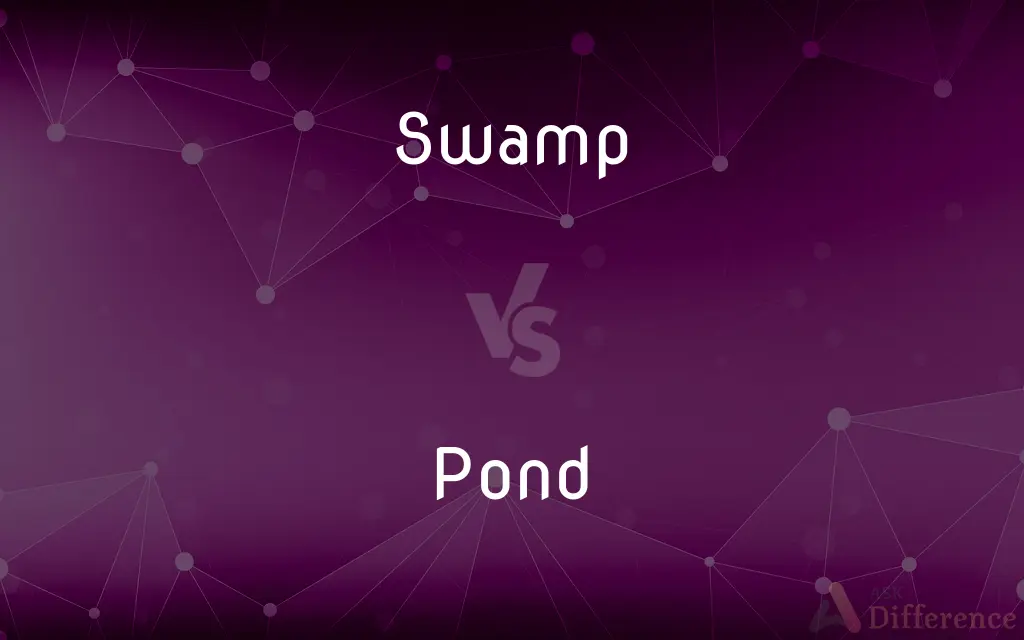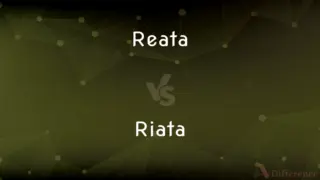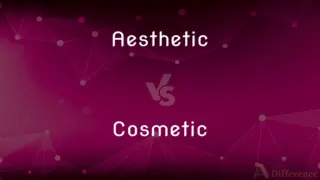Swamp vs. Pond — What's the Difference?
By Tayyaba Rehman & Maham Liaqat — Updated on March 3, 2024
Swamps are wetlands with standing water and vegetated by trees and shrubs, fostering diverse ecosystems. Ponds, small bodies of still water, support aquatic plants and animals, often man-made or natural.

Difference Between Swamp and Pond
Table of Contents
ADVERTISEMENT
Key Differences
Swamps are characterized by their wetland ecosystem, where water is present either seasonally or permanently, allowing for a unique environment where trees, shrubs, and various plants thrive. Whereas ponds are defined as small bodies of still water, either naturally occurring or man-made, that are shallow enough to allow sunlight to penetrate to the bottom, supporting a diverse range of aquatic life.
While swamps often have a significant amount of vegetation, including large trees and dense shrubbery, which contribute to a unique ecosystem supporting a variety of wildlife, ponds are typically open water areas that can support aquatic plants throughout their entire depth. This difference in vegetation affects not only the types of species that can live there but also the overall function and appearance of these water bodies. On the other hand, ponds are generally considered to be more tranquil and contained ecosystems compared to swamps, which can be vast and complex. Swamps play a crucial role in flood control and water purification, acting as natural sponges that absorb floodwaters and filter pollutants.
Swamps are often found in areas with poor drainage, leading to the accumulation of water and the formation of peat from decaying plant matter. Ponds, in contrast, can be found in a variety of landscapes and are often created to enhance a garden, provide a water source for agriculture, or serve as a habitat for fish and wildlife.
Swamps can support a wide range of plant and animal species, including species that are adapted to the fluctuating water levels. Ponds also contribute to biodiversity but on a smaller scale, offering a habitat for fish, amphibians, birds, and invertebrates.
Comparison Chart
Definition
Wetland with trees and standing water
Small body of still water
ADVERTISEMENT
Vegetation
Trees, shrubs, and aquatic plants
Aquatic plants, often around the edges
Water Presence
Seasonal or permanent, can be murky
Typically clear, can be seasonal or permanent
Ecosystem Type
Complex, supporting diverse wildlife
Simpler, supports aquatic life and plants
Function
Flood control, water purification
Aesthetic, habitat for fish and wildlife, recreational
Compare with Definitions
Swamp
Supports diverse species adapted to wet conditions.
Swamps provide critical habitat for waterfowl and other wildlife.
Pond
Generally clear, allowing for plant growth throughout.
The clear waters of the pond supported a lush bed of water lilies.
Swamp
Can vary, often murky due to vegetation and sediment.
The swamp's water level rises significantly during the rainy season.
Pond
Supports aquatic plants and animals.
Ponds are vital for the breeding of frogs and toads.
Swamp
Natural water filtration and flood control.
The swamp acts as a natural sponge, absorbing excess rainwater.
Pond
Aquatic plants, with some surrounding vegetation.
The pond's edge was lined with cattails and reeds.
Swamp
A wetland area with standing water, trees, and shrubs.
The swamp was teeming with life, from towering cypress trees to croaking frogs.
Pond
A small, still body of water shallow enough for sunlight to reach the bottom.
The pond was a tranquil spot, frequented by ducks and geese.
Swamp
Dominated by water-tolerant trees and plants.
Moss-draped oaks and bald cypress trees are common in swamps.
Pond
Aesthetic, recreational, or habitat purposes.
The pond was stocked with fish, providing recreation for local anglers.
Swamp
A swamp is a forested wetland. Swamps are considered to be transition zones because both land and water play a role in creating this environment.
Pond
A pond is an area filled with water, either natural or artificial, that is smaller than a lake. Ponds can be created by a wide variety of natural processes (e.g.
Swamp
An area of low-lying land that is frequently flooded, especially one dominated by woody plants.
Pond
A still body of water smaller than a lake.
Swamp
A lowland region saturated with water.
Pond
To form ponds or large puddles
Debris blocked the culvert, and the stream began to pond.
Swamp
A piece of wet, spongy land; low ground saturated with water; soft, wet ground which may have a growth of certain kinds of trees, but is unfit for agricultural or pastoral purposes.
Pond
To cause to form ponds or large puddles
The landslide ponded the stream.
Swamp
To drench or fill with water.
The boat was swamped in the storm.
Pond
An inland body of standing water, either natural or man-made, that is smaller than a lake.
Swamp
To become filled with water, as a boat; to founder; to capsize or sink; figuratively, to be ruined; to be wrecked.
Pond
A body of water, naturally or artificially confined, and usually of less extent than a lake.
Pond
To make into a pond; to collect, as water, in a pond by damming.
Pond
A small lake;
The pond was too small for sailing
Common Curiosities
Can both swamps and ponds be man-made?
While ponds are frequently man-made for various purposes, swamps are typically natural formations, although human activities can influence their creation and maintenance.
What distinguishes a swamp from a pond?
A swamp is a wetland with trees and seasonal or permanent standing water, supporting diverse ecosystems. A pond is a small body of still water, often clearer, supporting aquatic plants and animals.
How do ponds contribute to local ecosystems?
Ponds provide habitats for fish, amphibians, birds, and invertebrates, supporting biodiversity and serving as crucial breeding grounds for various species.
Can ponds freeze over in winter?
Yes, ponds can freeze over in winter, depending on their location and climate, affecting the types of plant and animal life they can support during those months.
How does water clarity differ between swamps and ponds?
Water in swamps is often murky due to organic matter and sediment, while ponds typically have clearer water, allowing sunlight to penetrate and support aquatic plants.
Are swamps found in specific climates?
Swamps can be found in a variety of climates, from the tropical wetlands to the temperate regions, wherever conditions allow for the accumulation of water and growth of water-tolerant vegetation.
What types of animals live in swamps?
Swamps can be home to a wide range of animals, including birds, fish, amphibians, reptiles, and mammals, many of which are specially adapted to the wetland environment.
Why are swamps important to the environment?
Swamps play critical roles in flood control, water purification, and providing habitat for diverse wildlife, contributing significantly to ecological health and biodiversity.
What is the main ecological function of a pond?
The main ecological functions of a pond include supporting aquatic life, contributing to local biodiversity, and serving as a water source for wildlife.
Why might someone create a pond?
People create ponds for aesthetic reasons, recreational activities such as fishing and swimming, wildlife habitat creation, and agricultural uses like irrigation.
Share Your Discovery

Previous Comparison
Reata vs. Riata
Next Comparison
Aesthetic vs. CosmeticAuthor Spotlight
Written by
Tayyaba RehmanTayyaba Rehman is a distinguished writer, currently serving as a primary contributor to askdifference.com. As a researcher in semantics and etymology, Tayyaba's passion for the complexity of languages and their distinctions has found a perfect home on the platform. Tayyaba delves into the intricacies of language, distinguishing between commonly confused words and phrases, thereby providing clarity for readers worldwide.
Co-written by
Maham Liaqat













































